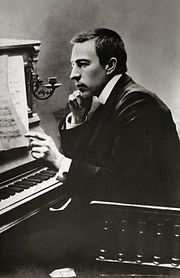Piano Concerto No. 2 (Rachmaninoff)
From Wikipedia, the free encyclopedia
| This article needs additional citations for verification. Please help improve this article by adding reliable references (ideally, using inline citations). Unsourced material may be challenged and removed. (March 2008) |
Piano Concerto No. 2, Op. 18, is a work in C minor for piano accompanied by orchestra, composed by Sergei Rachmaninoff between the autumn of 1900 and April 1901.[1] The second and third movements were first performed with the composer as soloist on 2 December 1900.[2] The complete work was premiered, again with the composer as soloist, on October 27, 1901,[2] with his cousin Alexander Siloti conducting.
This piece is one of his most enduringly popular pieces[3], and established his fame as a concerto composer.[4]
Contents |
[edit] Background
At its 1897 premiere, Rachmaninoff's first symphony, though now considered a significant achievement, was derided by critics.[5] Compounded by problems in his personal life, Rachmaninoff fell into a depression that lasted for several years. His second piano concerto confirmed his recovery from clinical depression and writer's block. The concerto was dedicated to Nikolai Dahl, a physician who had done much to restore Rachmaninoff's self-confidence.[6]
[edit] Composition
| This section may contain original research or unverified claims. Please improve the article by adding references. See the talk page for details. (July 2008) |
| Please help improve this article or section by expanding it. Further information might be found on the talk page. (September 2008) |
The work is scored for 2 flutes, 2 oboes, 2 clarinets in B♭ (I mov.) and A (II & III mov.), 2 bassoons, 4 horns in F, 2 trumpets in B♭, 3 trombones (2 tenor, bass), tuba, timpani, bass drum, cymbals, solo piano, and strings. It is written in three-movement concerto form.
[edit] Moderato: C minor

The opening movement begins with a series of bell-like tollings on the piano that build tension, eventually climaxing in the introduction of the main theme. In this first section, the orchestra carries the Russian-character melody while the piano makes an accompaniment made of arpeggios. After the statement of the long first theme, a quicker transition follows until the more lyrical second theme, in E flat major, is presented.
The agitated and unstable development borrows motives from both themes changing keys very often and giving the melody to different instruments while a new musical idea is slowly formed. The music builds in a huge climax as if the work was going to repeat the first bars of the work, but the recapitulation is going to be quite different.
While the orchestra restates the first theme, the piano, that in the other occasion had an accompaniment role, now plays the march-like theme that had been halfly presented in the development, thus making a considerable readjustment in the exposition, as the main theme, played by the orchestra has become an accompaniment. The rest of the recapitulation is quite literal, and the piece ends in C minor fortissimo.
[edit] Adagio sostenuto: C minor → E major
The second movement opens with a series of slow chords in the strings which modulate from the C minor of the previous movement to the E major of this movement. The piano enters, playing a simple arpeggiated figure. A flute then introduces the main theme. The motif is passed between the piano and other soloists before the music accelerates to a short climax centered on the piano. The original theme is repeated, and the music appears to die away, finishing with just the soloist in E major.
[edit] Allegro scherzando: E major → C Minor → C major
The last movement opens with a short orchestral introduction that modulates from E (the key of the previous movement) to C, before a piano solo leads to the statement of the agitated first theme. After the original fast tempo and musical drama ends, a lyrical theme is introduced by the oboe and violas. This second theme maintains the motif of the first movement's second theme. After a long period of development tension is built up considerably. Near the end, Rachmaninoff restates the second theme in loud, fortissimo orchestration. After this, a fast, ecstatic coda draws the piece to a close, ending in C major.
[edit] Media
|
|||||||||||||
| Problems listening to these files? See media help. | |||||||||||||
[edit] Further reading
- W.R. Anderson: Rachmaninov and his pianoforte concertos. A brief sketch of the composer and his style. London 1947
- So-Ham Kim Chung: An analysis of Rachmaninoff's Concerto No. 2 in C Minor opus 18. Aids towards performance. Dissertation Ohio 1988
[edit] Notes
- ^ Harrison, Max (2006). Rachmaninoff: Life, Works, Recordings. London: Continuum. pp. 92–99. ISBN 0-8264-9312-2.
- ^ a b Classy Classical: Rachmaninoff's Works for Piano and Orchestra
- ^ Guardian Newspaperhttp://www.guardian.co.uk/uk/2005/mar/29/arts.artsnews1
- ^ Norris, Geoffrey (1993). The Master Musicians: Rachmaninoff. New York City: Schirmer Books. pp. 113–115. ISBN 0-02-870685-4. http://books.google.com/books?id=aPc2AAAACAAJ.
- ^ Steinberg, Michael (1998). The Concerto. Oxford University Press. p. 357. ISBN 0-19-513931-3.
- ^ Steinberg, Michael (1998). The Concerto. Oxford University Press. p. 358. ISBN 0-19-513931-3.
[edit] References
- Schirmer, G (1996). Tchaikovsky's Piano Concerto No. 1; Rachmaninoff's Piano Concerto No. 2 (Orchestra reduction for second piano). Mineola, New York: Dover Publications. pp. 101–163. ISBN 0-486-29114-6.
- Yungkans, Jonathan (2001-03-14). "The Second Piano Concerto". The Flying Inkpot. http://inkpot.com/classical/rachpfc2.html. Retrieved on 2007-10-15.
- Kuenning, Geoff (2000). "Rachmaninoff: Piano Concerto No. 2 in C Minor". Symphony of the Canyons. http://www.lasr.cs.ucla.edu/geoff/prognotes/rachmaninoff/pianoCon2.html. Retrieved on 2007-10-15.
[edit] External links
- Rachmaninoff's Works for Piano and Orchestra An analysis of Rachmaninoff's Works for Piano and Orchestra including the Piano Concertos and the Paganini Rhapsody
- Piano Concerto No. 2: Free scores at the International Music Score Library Project.
|
|||||




